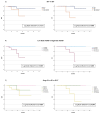Low-Risk and High-Risk NSMPs: A Prognostic Subclassification of No Specific Molecular Profile Subtype of Endometrial Carcinomas
- PMID: 39335192
- PMCID: PMC11429616
- DOI: 10.3390/cancers16183221
Low-Risk and High-Risk NSMPs: A Prognostic Subclassification of No Specific Molecular Profile Subtype of Endometrial Carcinomas
Abstract
(1) Background: Endometrial carcinoma (EC) classified as no specific molecular profile (NSMP) represents a heterogeneous group with variable prognoses. This retrospective, single-center study aims to further stratify NSMP ECs to tailor treatment strategies and improve outcomes. (2) Methods: From 2020 to 2023, we collected data on 51 patients diagnosed with NSMP EC following the introduction of molecular profiling at our institution. Patients were retrospectively analyzed for estrogen receptor (ER) status, histotype, and grade to identify potential prognostic subgroups. (3) Results: Our analysis identified two distinct subgroups within NSMP EC: low-risk and high-risk, based on ER status, histotype, and grade. The low-risk NSMP group demonstrated significantly better survival outcomes compared to the high-risk group. With a median follow-up time of 16 moths (IQR 13.0-29.7), the disease-free survival (DFS) and overall survival (OS) for the low-risk group were 100%. For the high-risk group, the DFS and OS were 71.4% and 78.6%, respectively, which showed a statistically significantly difference (Log-Rank Mantel-Cox < 0.001). In the high-risk group, four patients experienced recurrence, and three of these patients died. (4) Conclusions: Stratifying NSMP EC into low-risk and high-risk categories based on ER status, histotype, and grade can lead to more accurate prognostic assessments. In time, it may require tailored adjuvant therapies and a personalized treatment.
Keywords: NSMP; endometrial cancer; estrogen receptor; molecular classification; no specific molecular profile; prognosis; risk class.
Conflict of interest statement
The authors declare no conflicts of interest.
Figures




References
-
- Plotkin A., Kuzeljevic B., De Villa V., Thompson E.F., Gilks C.B., Clarke B.A., Köbel M., McAlpine J.N. Interlaboratory Concordance of ProMisE Molecular Classification of Endometrial Carcinoma Based on Endometrial Biopsy Specimens. Int. J. Gynecol. Pathol. 2020;39:537–545. doi: 10.1097/PGP.0000000000000654. - DOI - PubMed
-
- Stelloo E., Nout R.A., Osse E.M., Jürgenliemk-Schulz I.J., Jobsen J.J., Lutgens L.C., van der Steen-Banasik E.M., Nijman H.W., Putter H., Bosse T., et al. Improved Risk Assessment by Integrating Molecular and Clinicopathological Factors in Early-stage Endometrial Cancer-Combined Analysis of the PORTEC Cohorts. Clin. Cancer Res. 2016;22:4215–4224. doi: 10.1158/1078-0432.CCR-15-2878. - DOI - PubMed
-
- Stelloo E., Bosse T., Nout R.A., MacKay H.J., Church D.N., Nijman H.W., Leary A., Edmondson R.J., Powell M.E., Crosbie, et al. Refining prognosis and identifying targetable pathways for high-risk endometrial cancer; a TransPORTEC initiative. Mod. Pathol. 2015;28:836–844. doi: 10.1038/modpathol.2015.43. - DOI - PubMed
-
- Kommoss S., McConechy M.K., Kommoss F., Leung S., Bunz A., Magrill J., Britton H., Kommoss F., Grevenkamp F., Karnezis A., et al. Final validation of the ProMisE molecular classifier for endometrial carcinoma in a large population-based case series. Ann. Oncol. 2018;29:1180–1188. doi: 10.1093/annonc/mdy058. - DOI - PubMed
LinkOut - more resources
Full Text Sources

